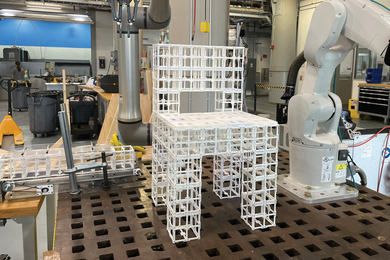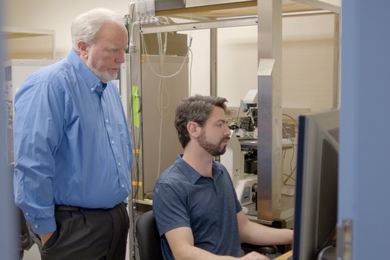As the United States seeks to reinvigorate its job market and move past economic recession, MIT News examines manufacturing’s role in the country’s economic future through this series on work at the Institute around manufacturing.
The manufacturing sector, its advocates note, is burdened by negative stereotypes. Outsiders often mistakenly think that manufacturing consists of jobs that are “dumb, dirty and dull,” as MIT President Susan Hockfield said at a conference on the subject this week.
Many people also view manufacturing as being in a state of continual decline, a perspective Hockfield has encountered frequently. During discussions about manufacturing around the country over the last 12 to 18 months, “the majority of people I met would assure me without any apparent concern that nothing is made in America,” Hockfield said. “And they would further assert that we should be resigned to the sector’s demise, that it somehow wouldn’t matter.”
The facts present a different story, however. The United States added about 50,000 manufacturing jobs this January alone, the largest monthly gain since 1998. Companies such as Ford Motor Co. have moved overseas plants back to the United States. And high energy costs (which make global shipping more expensive), along with rising foreign wages in some industries, have provided reasons for companies to consider relocating their factories in America.
In this regard, “the situation is different than it was in the 1990s,” when the flow of jobs seemed only to move away from the United States, said David Simchi-Levi, professor of civil and environmental engineering and engineering systems and co-director of MIT’s Leaders for Global Operations (LGO) program, which co-hosted the event. About 43 percent of firms in one survey, he noted, would consider moving their factories back to the United States.
To be sure, manufacturing has seen major job reductions in the United States: from 18 million jobs in 2001 to 12 million today. Even so, the sector still accounts for 70 percent of private-sector R&D spending in America and 90 percent of U.S. patents issued today, as U.S. Commerce Secretary John Bryson noted in his remarks at the conference on Wednesday, while listing a slew of administration policy proposals intended to boost manufacturing.
“Those who thought American manufacturing was somehow gone for good have been forced, I think, to re-examine their views,” Bryson said. “I strongly believe that manufacturing, particularly advanced manufacturing based on new technologies, is of fundamental importance to our country’s economic strength in the 21st century.”
A boost from government
The conference, “The Future of Manufacturing in the U.S.,” held on May 8 and 9 at MIT, featured talks by a range of government officials, business executives, management scholars, engineers, economists and labor representatives, with several hundred business leaders and students in attendance. The event was co-sponsored by LGO, a program that offers students both MBAs and engineering master’s degrees, and by MIT’s Industrial Liaison Program (ILP), which develops partnerships between MIT researchers and corporations from around the globe.
Many speakers, like Bryson, voiced the idea that manufacturing remains an essential component of economic growth in the United States.
“It’s very difficult to think about an innovation economy without manufacturing at the core of it,” said Daron Acemoglu, the Elizabeth and James Killian Professor of Economics at MIT, whose work examines, among other things, the institutional conditions that encourage innovation.
In that vein, a prime topic of discussion at the conference was how government can further encourage innovation; Bryson outlined a series of White House proposals to aid manufacturing. Many of these involve the tax code: tax credits that reduce moving expenses when companies bring jobs back to the United States; a permanent tax credit for R&D; and a reduction in the corporate tax rate.
Hockfield, who co-chairs the steering committee of the White House’s Advanced Manufacturing Partnership (AMP), discussed some of the imminent recommendations that group is going to make. These fall into three main categories, Hockfield noted: policies intended to improve the business climate for manufacturers; programs to encourage people to develop skills useful for manufacturing jobs, especially through community college education; and funding for new regional technology-development test beds called Manufacturing Innovation Institutes.
“No matter how brilliant our new innovations, they will not translate into the kind of strong economic growth and new jobs that we need unless some substantial fraction of goods are really made in America,” Hockfield said.
Many of the business leaders who spoke also called for new government policies to promote manufacturing.
“These jobs aren’t going to return on their own,” said Joseph Jimenez, CEO of pharmaceutical company Novartis, adding: “I believe we can reclaim leadership in manufacturing, but only if we act now.” Jimenez’s list of needed changes included more incentives for business investment; better worker training on the part of companies, not just within the education system; and continued innovation by U.S. firms.
Innovation from within
Indeed, in addition to government incentives, Jimenez said, U.S. manufacturers must “build leadership in manufacturing innovation” themselves. As he detailed, Novartis, in collaboration with MIT researchers, is working to develop a new system of “continuous manufacturing” that would dramatically reduce the time it takes to produce commercial drugs.
Similarly, Diana Tremblay, global chief manufacturing officer at General Motors Co., noted that along with the federal government’s efforts to pull the company out of its recent bankruptcy, many of the crucial changes in the firm involved manufacturing adjustments. GM is reducing its number of distinct vehicle architectures from 30 in 2010 to a planned 14 by 2018, she said, giving it more cost efficiency and design flexibility. When a major 24-hour assembly plant in Kansas recently needed to replace a 1.3 mile-long conveyor belt chain without shutting down for an extended time, she noted, its engineers figured out a new method of doing so: They replaced small increments of chain while the assembly line continued to run.
And while manufacturing executives frequently say they face a shortfall of skilled workers, William Green, executive chairman of the management consultant Accenture, said firms should always be able to find new ways of using their own employees to fill skills gaps in the manufacturing process.
“I’ve never seen a company that didn’t have talent trapped somewhere in its ecosystem,” Green said.
It remains to be seen precisely which areas of technological research will provide the biggest platforms for economic growth. Olivier de Weck, an associate professor of aeronautics and astronautics and engineering systems at MIT and executive director of the Institute’s ongoing study of Production in the Innovation Economy (PIE), listed a series of promising research topics, including lightweight materials, flexible electronics, pharmaceuticals, rapid prototyping — such as 3-D printing — and the use of recycled materials for manufacturing. PIE will release an interim report on its research in June of this year.
Thus, while manufacturing is not in a state of terminal decline, as some may think, it is still in a state of uncertainty.
“There is much more work to do to build on the positive trends we see, and create more jobs right here in the United States,” Bryson said.
The manufacturing sector, its advocates note, is burdened by negative stereotypes. Outsiders often mistakenly think that manufacturing consists of jobs that are “dumb, dirty and dull,” as MIT President Susan Hockfield said at a conference on the subject this week.
Many people also view manufacturing as being in a state of continual decline, a perspective Hockfield has encountered frequently. During discussions about manufacturing around the country over the last 12 to 18 months, “the majority of people I met would assure me without any apparent concern that nothing is made in America,” Hockfield said. “And they would further assert that we should be resigned to the sector’s demise, that it somehow wouldn’t matter.”
The facts present a different story, however. The United States added about 50,000 manufacturing jobs this January alone, the largest monthly gain since 1998. Companies such as Ford Motor Co. have moved overseas plants back to the United States. And high energy costs (which make global shipping more expensive), along with rising foreign wages in some industries, have provided reasons for companies to consider relocating their factories in America.
In this regard, “the situation is different than it was in the 1990s,” when the flow of jobs seemed only to move away from the United States, said David Simchi-Levi, professor of civil and environmental engineering and engineering systems and co-director of MIT’s Leaders for Global Operations (LGO) program, which co-hosted the event. About 43 percent of firms in one survey, he noted, would consider moving their factories back to the United States.
To be sure, manufacturing has seen major job reductions in the United States: from 18 million jobs in 2001 to 12 million today. Even so, the sector still accounts for 70 percent of private-sector R&D spending in America and 90 percent of U.S. patents issued today, as U.S. Commerce Secretary John Bryson noted in his remarks at the conference on Wednesday, while listing a slew of administration policy proposals intended to boost manufacturing.
“Those who thought American manufacturing was somehow gone for good have been forced, I think, to re-examine their views,” Bryson said. “I strongly believe that manufacturing, particularly advanced manufacturing based on new technologies, is of fundamental importance to our country’s economic strength in the 21st century.”
A boost from government
The conference, “The Future of Manufacturing in the U.S.,” held on May 8 and 9 at MIT, featured talks by a range of government officials, business executives, management scholars, engineers, economists and labor representatives, with several hundred business leaders and students in attendance. The event was co-sponsored by LGO, a program that offers students both MBAs and engineering master’s degrees, and by MIT’s Industrial Liaison Program (ILP), which develops partnerships between MIT researchers and corporations from around the globe.
Many speakers, like Bryson, voiced the idea that manufacturing remains an essential component of economic growth in the United States.
“It’s very difficult to think about an innovation economy without manufacturing at the core of it,” said Daron Acemoglu, the Elizabeth and James Killian Professor of Economics at MIT, whose work examines, among other things, the institutional conditions that encourage innovation.
In that vein, a prime topic of discussion at the conference was how government can further encourage innovation; Bryson outlined a series of White House proposals to aid manufacturing. Many of these involve the tax code: tax credits that reduce moving expenses when companies bring jobs back to the United States; a permanent tax credit for R&D; and a reduction in the corporate tax rate.
Hockfield, who co-chairs the steering committee of the White House’s Advanced Manufacturing Partnership (AMP), discussed some of the imminent recommendations that group is going to make. These fall into three main categories, Hockfield noted: policies intended to improve the business climate for manufacturers; programs to encourage people to develop skills useful for manufacturing jobs, especially through community college education; and funding for new regional technology-development test beds called Manufacturing Innovation Institutes.
“No matter how brilliant our new innovations, they will not translate into the kind of strong economic growth and new jobs that we need unless some substantial fraction of goods are really made in America,” Hockfield said.
Many of the business leaders who spoke also called for new government policies to promote manufacturing.
“These jobs aren’t going to return on their own,” said Joseph Jimenez, CEO of pharmaceutical company Novartis, adding: “I believe we can reclaim leadership in manufacturing, but only if we act now.” Jimenez’s list of needed changes included more incentives for business investment; better worker training on the part of companies, not just within the education system; and continued innovation by U.S. firms.
Innovation from within
Indeed, in addition to government incentives, Jimenez said, U.S. manufacturers must “build leadership in manufacturing innovation” themselves. As he detailed, Novartis, in collaboration with MIT researchers, is working to develop a new system of “continuous manufacturing” that would dramatically reduce the time it takes to produce commercial drugs.
Similarly, Diana Tremblay, global chief manufacturing officer at General Motors Co., noted that along with the federal government’s efforts to pull the company out of its recent bankruptcy, many of the crucial changes in the firm involved manufacturing adjustments. GM is reducing its number of distinct vehicle architectures from 30 in 2010 to a planned 14 by 2018, she said, giving it more cost efficiency and design flexibility. When a major 24-hour assembly plant in Kansas recently needed to replace a 1.3 mile-long conveyor belt chain without shutting down for an extended time, she noted, its engineers figured out a new method of doing so: They replaced small increments of chain while the assembly line continued to run.
And while manufacturing executives frequently say they face a shortfall of skilled workers, William Green, executive chairman of the management consultant Accenture, said firms should always be able to find new ways of using their own employees to fill skills gaps in the manufacturing process.
“I’ve never seen a company that didn’t have talent trapped somewhere in its ecosystem,” Green said.
It remains to be seen precisely which areas of technological research will provide the biggest platforms for economic growth. Olivier de Weck, an associate professor of aeronautics and astronautics and engineering systems at MIT and executive director of the Institute’s ongoing study of Production in the Innovation Economy (PIE), listed a series of promising research topics, including lightweight materials, flexible electronics, pharmaceuticals, rapid prototyping — such as 3-D printing — and the use of recycled materials for manufacturing. PIE will release an interim report on its research in June of this year.
Thus, while manufacturing is not in a state of terminal decline, as some may think, it is still in a state of uncertainty.
“There is much more work to do to build on the positive trends we see, and create more jobs right here in the United States,” Bryson said.







